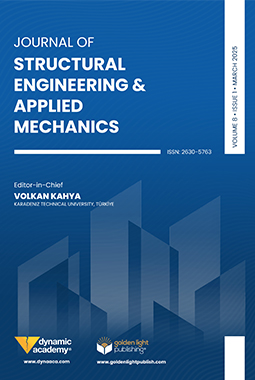ISSN:2630-5763
Journal of Structural Engineering & Applied Mechanics
ARTICLES
M. Amiri
M. Bateni
Mohamad Reza Eslami
This work presents the dynamic coupled thermoelastic response of thin spherical shells
subjected to a transverse thermal shock. The shell under investigation is assumed to be
sufficiently thin to neglect the curvature effect through the thickness. Also, the shell is
considered to be constituted from homogenous and isotropic material. The Hooke and
Fourier laws, respectively, are considered to govern the mechanical and thermal behavior
of the constituent material. Under the applied load, it is assumed that the displacements
of the shell remain in the infinitesimal range. Hamilton’s principle is utilized for derivation
of governing equations of motion for the shell. For thermal part of the problem, the twodimensional
coupled energy equation is assumed to govern the temperature field in the
shell. Applying the Galerkin method in thickness direction of the shell, two-dimensional
energy equation is reduced to two one-dimensional ones in meridian direction of the shell.
To solve the fully coupled motion and energy equations, the finite element method is used
for spatial discretization, and the Newmark method is used for temporal discretization.
A validation case study is conducted by comparing the results of the present work and
those which is obtained by the ABAQUS software.
https://doi.org/10.31462/jseam.2019.02053062
Dersu Yılmaz
Kurtuluş Soyluk
In this study, it is intended to investigate specifically the directivity-pulse and fling-step characteristics of near-fault ground motions on deck-type steel arch bridges. As known, near-fault ground motions have different dynamic characteristics than far-fault ground motions characterized by directivity pulse and fling step effects which usually have important effects on structural systems. The New River Gorge Bridge constructed in the USA is selected as a numerical example to determine the response of this type of steel arch bridges under the specified characteristics of near-fault ground motions. As near-fault ground motions 1999 Chi-Chi Earthquake strong ground motion recordings of TCU102, TCU089 and HWA032 are used. The bridge responses obtained for the near-fault ground motions showing directivity-pulse and fling-step characteristics are compared with each other and with those of the responses obtained for the far-fault ground motion to emphasize the relative importance of directivity-pulse and fling-step effects. The results revealed that both directivity-pulse and fling-step characteristics of near-fault ground motions have considerable effects on steel arch bridge responses and therefore should be taken into account in the design phase of these bridges.
https://doi.org/10.31462/jseam.2019.02063074
İsa Çömez
Korhan Babacan Yılmaz
Mehmet Ali Güler
Bora Yıldırım
In this paper, the moving contact problem between the punch and a layer supported by a Winkler type foundation is considered under plane strain conditions. The cylindrical punch moves smoothly with constant velocity over the homogeneous layer. With the use of Galilean transformation and Fourier integral transform, the plane contact problem is converted into a Cauchy type singular integral equation. The singular integral equation is solved numerically by performing the appropriate collocation method, and the contact width, the contact and in-plane stresses are calculated. The results show that the stiffness of the Winkler foundation and the moving velocity have a significant effect on the contact width and the behavior of the stress field.
https://doi.org/10.31462/jseam.2019.02075087
Fatih Alemdar
Neslihan Avcı
Physical properties such as displacement obtained by experimental methods in civil engineering structures and modal parameters contain important information about the current state of the structure. The determination of these parameters is usually done by the time history analysis of the data collected by acceleration, velocity and displacement. In order to determine the structure behaviour under dynamic effects, a finite element analysis is often preferred. In this study, the effects of earthquake acceleration records applied in different ratios in the 3D steel frame system with semi-rigid joint are investigated. The analysis results reveal that the effect of semi-rigid connections on structural systems is significant. In the 3 storey steel frame with semi-rigid assembly, the effect of these connections on the system is presented numerically and visually. Comparison of the dynamic displacement of finite element model with experimental data has %99 achieved in good relation with visual inspection.
https://doi.org/10.31462/jseam.2019.02088095


